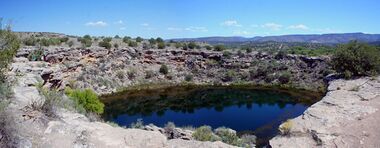Biology:Motobdella montezuma
| Motobdella montezuma | |
|---|---|
| Scientific classification | |
| Kingdom: | |
| Phylum: | |
| Class: | |
| Subclass: | |
| Family: | |
| Genus: | |
| Species: | M. montezuma
|
| Binomial name | |
| Motobdella montezuma (Davies, Singhal & Blinn, 1985) [1]
| |
| Synonyms [2] | |
|
Erpobdella montezuma Davies, Singhal & Blinn, 1985 | |
Motobdella montezuma is a species of leech which is only found in Montezuma Well, central Arizona, United States . It is a nocturnal pelagic predator that feeds almost exclusively on the endemic amphipod Hyalella montezuma, which it detects using passive sonar and swallows whole.
Description
Adults of M. montezuma may reach a length of 71 mm (2.8 in) including the suckers at the front and rear.[3]
Distribution
M. montezuma is closely related to the genus Erpobdella,[4] which includes species that are widespread across North America from Alaska to Mexico.[5] However, M. montezuma is only known to occur in a single pool, Montezuma Well, in the Montezuma Castle National Monument in Yavapai County, Arizona.[6]
Ecology
Montezuma Well, due to a high carbon dioxide level in the water, is unable to support a population of fish, leaving an ecological niche of predator-free open water. Although there are a number of species of invertebrates living in the well, the diet of M. montezuma consists almost entirely of the endemic amphipod Hyalella montezuma.[6]
Behavior
M. montezuma is nocturnal, resting at the bottom of the well during the day, when predatory waterfowl are present.[7] As night falls, the leeches swim towards the surface and hunt amphipods near the surface; this is the only instance of a leech hunting in open water.[7] Prey are detected by passive sonar, and swallowed whole. This pattern of diel vertical migration by a leech is only known to occur in Montezuma Well.[7]
Life cycle
Like many other leeches, M. montezuma is hermaphroditic. Sexual reproduction results in two individuals fertilizing each other, and the resulting eggs are placed in a nutrient-filled cocoon. The cocoon is placed deep enough to avoid the attention of ducks and other predators, and the eggs hatch into self-sufficient juveniles.[7]
References
- ↑ "Motobdella montezuma". Integrated Taxonomic Information System. https://www.itis.gov/servlet/SingleRpt/SingleRpt?search_topic=TSN&search_value=568959.
- ↑ "Erpobdellidae". Texas A&M University. http://insects.tamu.edu/research/collection/hallan/test/Annelida/Family/Erpobdellidae.txt.
- ↑ Fredric R. Govedich; Dean W. Blinn; Paul Keim; Ronald W. Davies (1998). "Phylogenetic relationships of three genera of Erpobdellidae (Hirudinoidea), with a description of a new genus, Motobdella, and species, Motobdella sedonensis". Canadian Journal of Zoology 76 (12): 2164–2171. doi:10.1139/cjz-76-12-2164.
- ↑ James H. Thorp; Alan P. Covich (2001). Ecology and classification of North American freshwater invertebrates (2nd ed.). Academic Press. ISBN 978-0-12-690647-9.
- ↑ Roy T. Sawyer (1970). "Observations on the natural history and behavior of Erpobdella punctata (Leidy) (Annelida: Hirudinea)". American Midland Naturalist 83 (1): 65–80. doi:10.2307/2424006.
- ↑ 6.0 6.1 Blinn, Dean W.; Davies, Ronald W.; Dehdashti, Behrooz (1987). "Specialized pelagic feeding by Erpobdella montezuma (Hirudinea)". Holarctic Ecology 10 (3): 235–240.
- ↑ 7.0 7.1 7.2 7.3 "All about the leeches of Montezuma Well". National Park Service. 2005. http://www.nps.gov/moca/naturescience/upload/Montezuma_Well_Leeches.pdf.
Wikidata ☰ Q3698463 entry


